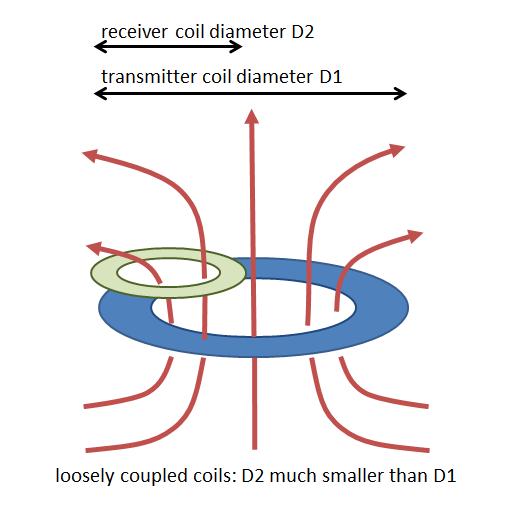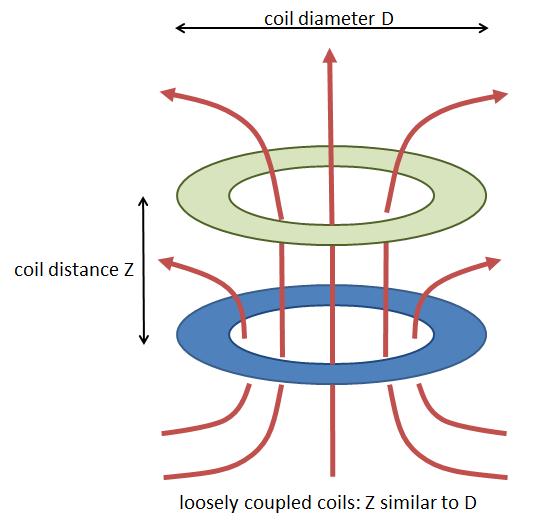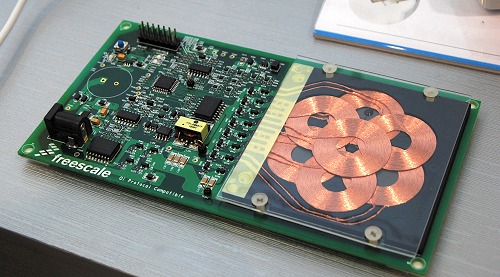The State of Wireless Charging Standards in Mobile
by Andrei Frumusanu on April 2, 2015 8:00 AM ESTInductive Coupling - The Basics
With the history of wireless charging out of the way, the remaining is question is how does it all work? To start, we need to understand the basics of inductive coupling.
Power transfer of inductive coupling happens by creating an alternating magnetic field on the transmitter coil, that magnetic flux is then converted into an electrical current in the receiver coil. The generated electrical current depends on the amount of flux generated by the transmitter coil, and how much of a percentage the receiver coil is able to capture. The distance, size, and positioning of the receiver coil relative to the transmitter coil decides the “coupling factor” of the two coils.
A higher coupling factor means a more efficient power transfer through loss reduction and less heating. In general, we differentiate between tightly coupled and loosely coupled systems.

Source: WPC
In tightly coupled systems, the transmitter and receiver coils both are of the same diameter size and aligned with each other with a minimal distance in-between them. This setup ensures most of the magnetic flux is captured by the receiver coil to be able to be converted into an electrical current.
Loosely coupled systems are defined by setups which do not capture all of the transmitter’s flux, either because the receiver coil distance is too big, or because the coil diameters don’t match and the receiver coil is smaller than the transmitter coil.


Source: WPC
While we mention loosely coupled systems and we’ll get back to them short when investigating Rezence charging, both WPC and PMA standards based on tightly coupled systems.
Optimal alignment of the transmitter to the receiver coil is crucial for a high coupling factor and high efficiency power transmission; because of this, there is a problem of practicality to actually achieve this alignment. To alleviate the issue, Qi transmitters allow for multiple transmitter coils that may overlap.

Source: WPC
By employing multiple transmitter coils over each other, we have a greater area of “optimal coupling” over which a device can be placed on. The control IC of the charging system will then detect which coil is best suited for the power transmission and then use that one for generating the magnetic flux. It is also possible to power on multiple coils simultaneously to achieve a higher power transfer if the receiver device is designed for it.
WPC & PMA Power Control
In Qi and PMA based systems, control over how the coils are powered is done via data communication between the transmitter and the receivers. This is done via data modulation (Either amplitude or frequency based) on the power carrier frequency. The in-band communication requires advanced signal processing and this is where manufacturers’ solution ICs come into play.
WPC wireless power functional diagram, Source: Texas Instruments
This communication is also the main difference and source of incompatibility between the Qi and PMA standards, as without a reliable and interoperable signal the charging process will not start. Powermat differs to Qi by using RFID handshake instead of modulation on the power signal.
The direction of power transfer is always from power transmitter to power receiver. The transmitter idles with in a low power state, which depending on vendor is in the 60mW range. When the power receiver detects a transmitter, it identifies itself to the transmitter as a compliant device and sends configuration information such as the desired charging power. Once power transfer is initiated, the receiver can send error packets requesting more or less power. The power transmission stops upon either receiving an “End Power” message or a period of non-communication of 1.25s.
The coils of a WPC-compliant device operate as resonant half-bridge on a 50% duty cycle with a 19V(±1V) DC power input. Depending on power demand, the frequency in the coil is modulated between 110 and 205 kHz. Powermat on the other hand works in the 277-357 kHz range.
On the receiver side, WPC gives the manufacturers much more liberty in terms of coil-design. While the transmitter is required to have a certain size and provide certain power for standard’s sake, the receiver is allowed to vary in size to adapt to the device form factor the system is implemented into.
Qi in its first low-power specification allows up to 5W of power transfer, with a revision on newer charging systems allowing up to 10W.
Unfortunately PMA does not publicize the standard’s specifications to non-members, so we don’t have any finer details on how it compares to Qi. It’s nevertheless safe to assume that the basic principles of the two standards work in similar fashion.











90 Comments
View All Comments
blanarahul - Thursday, April 2, 2015 - link
The problem is that data wireless signals don't add up to more than 2-3 watts. With wireless power that figure can go anywhere from 20-70Watts. That's a lot.Daniel Egger - Friday, April 3, 2015 - link
> It's a distance thing. If you're really really close to it, yes, it'll have a far more powerful effect than the earth's magnetic pull. The earth's magnetics are far more prevalent, though, because it's so massive.True but totally missing the point. A permanent magnet is something completely different than a wireless transmitter is what I was trying to say.
robl - Thursday, April 2, 2015 - link
I currently use wireless charging with my Nexus7. I had a 1st generation device, and either the usb port or the charging electronics became intermittent and died, probably through repeated connect/disconnects of the cable. Wireless charging on the 2nd generation device should work around it. I agree with the article, getting proper placement of the device is hard, but I got used to it and it's "there" 90% of the time. So a charging standard that is less efficient but allows for much easier placement will be a complete win for me. Yes, I wish I wouldn't be wasting power, but imagine this will continue to improve with future generations...sonicmerlin - Thursday, April 2, 2015 - link
You forgot to mention Witricity, which while a part of the Rezence standard, also offers "highly resonant" magnetic coupling that allows for charging over multiple feet rather than inches.Also timeline-wise they announced the WiT-5000C3 development kit in November last year so companies could start creating devices compliant with the Rezence standard. Intel has adopted the Rezence standard, so you'll be seeing wireless charging in laptops next year.
If you were wondering (like I was) why it's taken so long for Witricity (which demoed at TED in 2009) to come to market, there's a good engadget video explaining it (starting at 8:30): http://www.engadget.com/2014/11/07/witricity-ceo-e...
hobostu3000 - Thursday, April 2, 2015 - link
I use the Qi-Infinity portable wireless power bank to charge my phone on the go. It's nice not having to carry around a USB cable and a power bank. It can be tricky but I'm also able to place my phone and the charger in my front pocket in order to charge my phone while walking around. The power bank also has the option of charging via USB so I can always charge via cable in the front pocket option isn't available.alin - Thursday, April 2, 2015 - link
Please tell me how can you answer a phone and still charging it in the same time?What about answering the phone with it's battery almost dead and egaging in a conversation.
You still need a wall socket for the wireless adaptor.
And if you find it hard to plug in the usb cable in your phone, sorry, but, your smartphone is smarter than you :)
Houdani - Thursday, April 2, 2015 - link
The secret to wireless charging is to NOT wait until you have no charge left. That's the selling point. Don't wait until you absolutely need a charge. Just set it down when you're not otherwise using it and it'll stay topped off.Yes, you could also follow this practice with a USB cord, too. But the nuissance of futzing with a cord keeps folks from bothering.
Impulses - Thursday, April 2, 2015 - link
Exactly, after getting a couple wireless chargers I find I charge more often... Never liked using the phone plugged in anyway, cord either gets in the way or I feel like I'm about to damage the port.mkozakewich - Thursday, April 2, 2015 - link
You can use an external battery. Ideally, that battery could charge wirelessly.Dorek - Thursday, April 2, 2015 - link
"Please tell me how can you answer a phone and still charging it in the same time?"...the speakerphone?